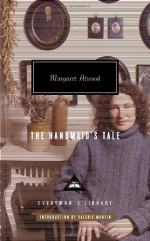|
This section contains 6,470 words (approx. 22 pages at 300 words per page) |

|
SOURCE: Feuer, Lois. “The Calculus of Love and Nightmare: The Handmaid's Tale and the Dystopian Tradition.” Critique 38, no. 2 (winter 1997): 83-95.
In the following essay, Feuer discusses ways in which Margaret Atwood's The Handmaid's Tale both partakes of and extends the dystopian genre, focusing on Atwood's questioning of certainty and truths in the novel.
Reviewers of Margaret Atwood's The Handmaid's Tale invariably hailed it as a “feminist 1984,”1 and, like many handy tags, this one conceals a partial truth. A closer look, however, reveals not only the similarities between the two novels' totalitarian societies, but the ways in which Atwood's work goes beyond Orwell's, in matters of style that become matters of substance as well as in the feminist debate over “essentialism” that Atwood brings to the dystopian tradition. The novel transforms that tradition stylistically as well as thematically as Atwood, aware of her predecessors (a persistent Atwood trait: consider...
|
This section contains 6,470 words (approx. 22 pages at 300 words per page) |

|


